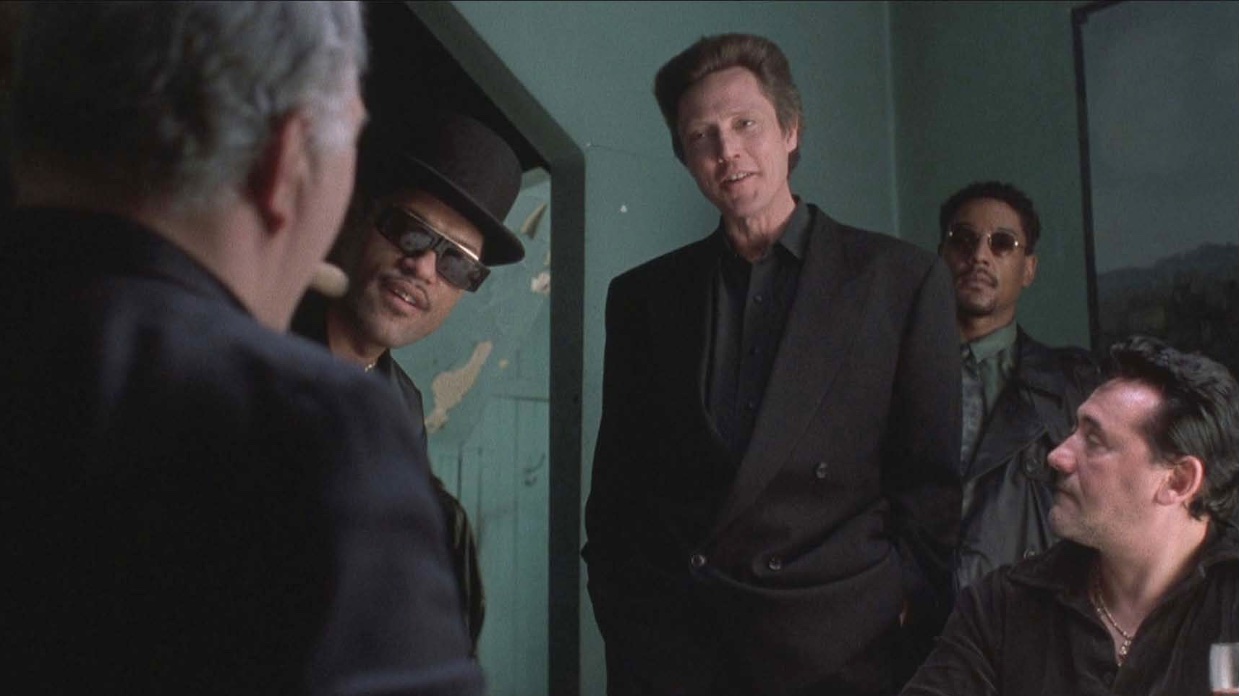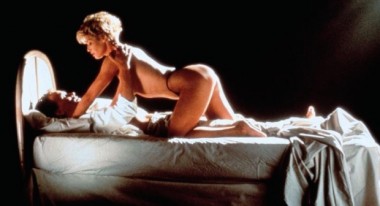 Back to selection
Back to selection
Put It In Writing: Living Through the Films of Abel Ferrara, Part Three
 King of New York
King of New York Evan Louison last wrote about Abel Ferrara for Filmmaker‘s 25th anniversary issue in his report, “Letter from Rome.” Given the assignment to interview Ferrara in conjunction with his month-long MoMA retrospective, Louison responded with a five-part personal memoir that tracks the impact of the director and his work on his own life. Check back each day this week for the next in the series, and read Part One and Part Two.
“The nature of evil is that it’s seductive.
If evil presented itself to us as it really is…
no one would be lured. No one would get tricked into it.”
— Nicholas St. John
Coming off of Driller Killer and Ms. 45, Abel makes the sojourn to the studio system — only to come away more convinced than ever that he’s not built for the lots. In retrospect it becomes impossible to view his work through any other prism than one oriented in struggle. For Abel, his first steps into the studio waters, Fear City and Elmore Leonard’s Cat Chaser — both of which see the writing process and rights to final cut taken away from him == leave a bad taste in his mouth, one that informs his work even today.

You gotta understand, they destroyed Fear City, he says. They destroyed Cat Chaser. I had both these films, and they were snatched out of my hands. And I was never gonna let that happen again. Look, we’re not talking about business here. We’re talking about this holy fucking thing that is making the best possible film, and it’s got nothing to do with what these producers think, or what they know about audiences — they don’t know shit. We’re the ones shooting the thing, we’re the ones who know the characters, the story, we’re the ones who got the goods.
In the interim between these two experiences, Abel makes his reputation as competent journeyman, directing one of the best-rated pilots in primetime network television (Crime Story), two renowned episodes of Miami Vice, and a pair of pilots that go nowhere: The Loner for Aaron Spelling, and The Gladiator with Ken Wahl, which plays like some bizarre hybrid of two Reagan-era staples of entertainment, the long-form social-ill PSA and the vigilante picture. None of these compare with China Girl, which falls in the middle of these, and is for the most part an unfairly forgotten masterwork. LA’s where I started to go off the rails man, Abel says. The place is like a cesspool. It’ll suck you dry. It’s a dangerous game…
While Fear City sees him battling the MPAA and his own producer, with 20th Century Fox eventually dumping the release after significant cuts did little to mitigate concerns about the film’s graphic depiction of Times Square cabaret clubs and sadistic violence, Cat Chaser emerges from a notoriously troubled production in Miami only to see its release tarnished with an edit that removes crucial sequences and saddles the picture with an explanatory voiceover from a non-existent character.
But time and again, when Abel’s trajectory is marred by interference, it is then redeemed with inspiration and perseverance. Over the next three years he sets the stage for what will be his lion’s prize. These works define his legacy, and in turn become the seeds of my own journey.
When you get home the evening of the great video store heist, after everyone else goes to bed, you quietly put on King of New York, loading it into the VCR, seated in a crouch less than a foot from the TV. As the first images of Sing-Sing’s interior appear, the camera tracks right out of black across a row of bars, a cell door with an inmate seated inside. His back to you. A guardstick raps on the bars and the man stands and turns, still in shadow as the cell door opens. The man steps into the doorway and pauses, the camera pushing in slightly on him. He emerges from the dark and finds the light, and you see his face. He looks so tired.
This is Frank White.
King of New York is the first of Abel’s films you see and possibly the most formative, but sadly it remains more known for the histrionic violence of its third act than for its clown car of a cast, its loose play upon the tired tropes of cops and gangsters’s parallel lives, or the exquisite lyrical pantomime of its lead. But it all begins with a vivid text by St. John, which Abel developed over the course of five years. When asked about the period that preceded King of New York’s financing — sourced from foreign moneys in a precedent-setting moment for his work, one that seems now in retrospect to foretell the future — Abel relates the film’s conception and execution in terms of control.
Every single shot, he says, and I mean, every last fucking frame of that movie is composed down to the inch. It’s a fucking miracle, like all our films. But that one, there’s a precision there that we never got even close to before. It was a reaction. Like, watch this.
The film’s script is often at odds with the finished picture, but in the most profound way, the players improve upon St. John’s language. Not least among these amendments is the casting of Laurence Fishburne as Jimmy Jump, Frank’s most loyal and oldest friend. In the script, Jim is white, Italian, and hot-headed — hence his nickname. Fishburne takes the role and brings an unhinged, at times even possessed quality to it. Watching his final moments in battle with Wesley Snipes’ Tommy Flanagan, a ruthless, unhinged cat-and-mouse gunfight, is like witnessing an exorcism. Jimmy Jump’s heat and passion, his demons, are the polar opposite of Frank’s asexual eyes, filled with ice and antipathy.
Years after when you should have outgrown it, and even now, it’s the muted, distant remove setting Frank White apart from his crew’s Dionysian excesses that stays with you. Walken’s petrified countenance, perpetually numb from time lost in prison, alternates between stone-dead chills, the delivery of doom-laden pronouncements to anyone who gets in his way, and barely contained smiles. His gaze casts over the skyline of his city, filled with a longing for a world he cannot manage to conquer. A world that never existed and never will. At times, he spikes the lens purposefully. In these moments, Frank White stares directly at us, letting us know he sees us too. Reminding us whose city it is. In a film about the ultimate outsider, the chronicle of an untethered young outlaw who becomes more than base in his misanthropy, and beyond bitter once repatriated, he is truly the man who fell to earth, with an overwhelming sense of malice, his cross to bear.
In your life, King of New York plays on constant rotation. Even in the background, at times incessantly, over the next two decades you clock what must be hundreds of viewings. For all its flaws, like so many of your most hallowed landmarks, it shines still. Like a kind of beacon, signaling — This is what’s possible.
As with any master, for all of Abel’s touchstone features, there are of course the films that were never made. What could have been. In any conversation with Abel, there are allusions to the ghosts of movies past, movies never born or born dead and killed off, throughout. Fear City is made in chasm created by a “political dynamite stick of a project,” that goes nameless and unspecified, some kind of otherworldly, revolutionary thriller intended to follow up Ms. 45, that was not to be. At times, the list of lost possibilities seems endless. Along the way there are the Walken-written John Holmes biopic, slated to star Eric Roberts; the rumored “Catholic Western,” which supposedly took its roots in Ford’s The Searchers; the present-day Jekyll and Hyde with Forest Whitaker and 50 Cent; the La Dolce Vita sequel, with either Benicio Del Toro or Steven Bauer (depending on who you talk to) as Mastroianni’s character Rubini’s son. There’s Crack City Terminator, a scene-by-scene modern retelling of Kurosawa’s Yojimbo. There’s Birds of Prey, another surrealist, Ballardian / Gibson-esque thriller where Los Angeles is a corporate police state where poverty is considered a capital offense. There’s the version of Pasolini slated to star Zoe Lund, Thana herself, as the ill-fated poet and director. There’s the version of Bad Lieutenant with Christopher Walken. There’s rumors of Abel’s attachment to Pericle il Nero, a Neapolitan crime saga eventually made by Belgian filmmakers with no connection to the project’s inception; a prequel to King of New York, known as The Last Crew, supposedly inspired by Roy DeMeo’s Gambino-era Murder Machine gang; and a Broadway revival of Miguel Pinero’s Short Eyes — all of which never see the light of day. These are just a fraction of what is known. But alongside the tragic outcomes of Fear City and Cat Chaser, King of New York is followed by a major project’s preparation, of which nearly all of Abel’s involvement in it is forgotten.
In 1990, after seeing King of New York, producer Martin Bregman approaches Abel to direct the adaptation of Judge Edwin Torres’ (Q&A) novels After Hours and Carlito’s Way. The film goes on to be made with Brian DePalma at the helm some seven years later, to either acclaim or derision, again depending on which cultural perspective consulted. But details are murky as to what transpires that leads to Abel’s leaving the project. By all accounts, Abel is at that time set to take on the world and lend an air of authenticity to the mainstream New York underworld drama, a genre that previously none but Martin Scorsese and Sidney Lumet could seem to do justice to. Abel is, due to his pedigree and work ethic, considered legitimate, and his interpretation of the material coveted. And yet trades from that time do not mention Abel’s name in relation to the film.
The only relay of the project’s provenance come from Abel’s longtime collaborators, DP Ken Kelsch and actor Paul Calderon. Kelsch recalls Abel reaching out to him sometime in early 1991, after not speaking since working on Driller Killer: He calls me up in the middle of the night, saying ‘I just got fired off a movie, but I got something else ready to go.’
Calderon remembers the project’s dissolution with a greater sense of the impact created by the loss that occurred. He was attached because of his credentials, and then something happened. It was something trivial, but he made someone angry, rubbed someone the wrong way, and soon the question of ‘Who is that?, ‘Oh that’s Abel Ferrara, he’s going to direct Carlito’s Way,’ became ’Wrong — he was going to direct it.’ It was a major blow for both of us. But that’s how Bad Lieutenant happened. Without that disappointment, we would never have gotten so deep into that other material, which was so much darker.
This is how a masterpiece comes to be. As a reaction. A survival mechanism in full force. As an instinct to pivot from out the way of a landslide. In hindsight, one can only imagine what possible course history takes if the cards dealt to you come up otherwise. But in this case, no one in their right mind could possibly wish it any other way.
Evan Louison is a New York writer. Abel Ferrara: Unrated runs May 1-31st at the Museum of Modern Art.
